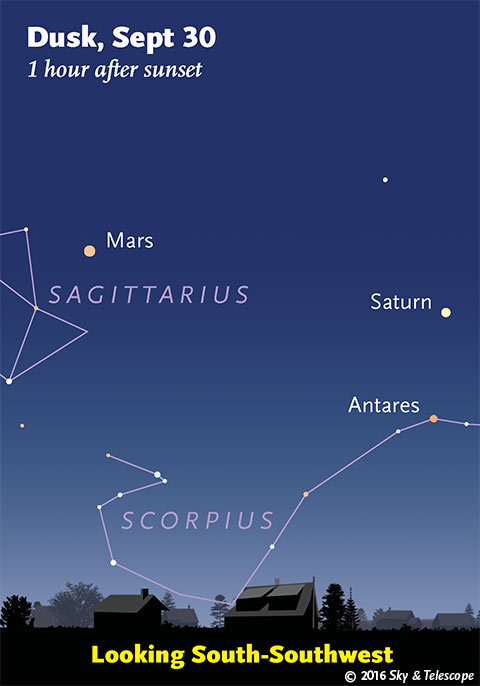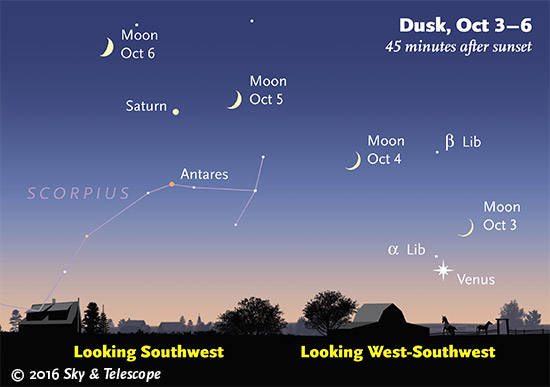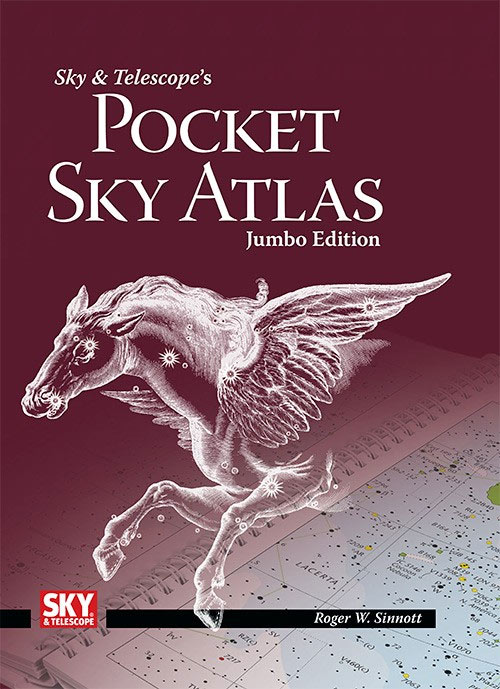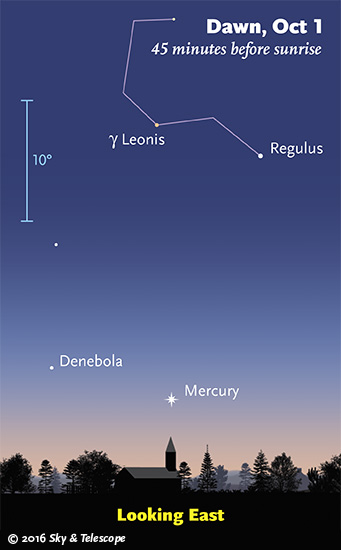
Friday, September 30
• This is the time of year when the Little Dipper extends left from Polaris after dark. The Little Dipper's only two bright stars are Polaris (the end of the Dipper's handle) and Kochab (the lip of its bowl). Both are 2nd magnitude. You'll find them exactly level with each other about a half hour after dark now, depending on your latitude.
• New Moon (exact at 8:11 p.m. Eastern Daylight Time).
Saturday, October 1
• Deneb takes over from Vega as the zenith star after dark at this time of year (for mid-northern latitudes), which means dim Capricornus takes over from Sagittarius as the zodiacal constellation standing due south.
Sunday, October 2
• A twilight challenge. About a half hour after your local sunset time, look for Venus very low in the west-southwest through the twilight. Some 10° to its right (for North America) is the thin crescent Moon. Although Venus is still lurking low, it's on its way to shining high and brilliant this winter.
• Even as the stars begin to come out in twilight, Cassiopeia is already higher in the northeast now than the sinking Big Dipper is in the northwest. Cassiopeia's broad W pattern is almost standing on end.
Monday, October 3
• The waxing crescent Moon is thicker and easier to see now in the west-southwest in twilight, though it's still not high, as shown below. Venus is now about 4° lower left of it (two or three finger-widths at arm's length).

Tuesday, October 4
• As twilight fades, the Moon is poised between Venus to its lower right and the Saturn-Antares pair to its left, as shown above. Antares twinkles 6° below Saturn.
• Vega is the brightest star very high in the west at nightfall. Arcturus, equally bright, is getting low in the west-northwest. The brightest star in the vast expanse between them, about a third of the way from Arcturus back up toward Vega, is Alphecca, magnitude 2.2 — the crown jewel of Corona Borealis. Alphecca is a 17-day eclipsing binary, but its brightness dips are too slight for the eye to see reliably.
Wednesday, October 5
• The Moon this evening forms the right-hand corner of a triangle with Saturn and lower Antares, as shown above.
• After dark, look just above the northeast horizon — far below high Cassiopeia — for bright Capella on the rise. How soon Capella rises, and how high you'll find it, depends on your latitude. The farther north you are, the sooner and higher.
Thursday, October 6
• The Moon forms the top left corner of a skinny triangle with Saturn and Antares, as shown above.
• Far to their left shines Mars. This evening Mars is passing just 0.2° below the top star of the Sagittarius Teapot, Lambda Sagittarii. The star, magnitude 2.8, is a dozen times fainter than Mars, magnitude +0.1.
Friday, October 7
• Look south-southwest at dusk for Mars shining lower left of the Moon. Mars is still near Lambda Sagittarii.
Saturday, October 8
• First-quarter Moon (exact at 12:33 a.m. tonight EDT). This evening the Moon shines in Sagittarius. It's far below 1st-magnitude Altair, and above Mars and the tilting Sagittarius Teapot.
_________________________
Want to become a better astronomer? Learn your way around the constellations! They're the key to locating everything fainter and deeper to hunt with binoculars or a telescope.
This is an outdoor nature hobby. For an easy-to-use constellation guide covering the whole evening sky, use the big monthly map in the center of each issue of Sky & Telescope, the essential guide to astronomy.

Once you get a telescope, to put it to good use you'll need a detailed, large-scale sky atlas (set of charts). The basic standard is the Pocket Sky Atlas (in either the original or new Jumbo Edition), which shows stars to magnitude 7.6.
Next up is the larger and deeper Sky Atlas 2000.0, plotting stars to magnitude 8.5, nearly three times as many. The next up, once you know your way around, is the even larger Uranometria 2000.0 (stars to magnitude 9.75). And read how to use sky charts with a telescope.
You'll also want a good deep-sky guidebook, such as Sue French's Deep-Sky Wonders collection (which includes its own charts), Sky Atlas 2000.0 Companion by Strong and Sinnott, or the bigger Night Sky Observer's Guide by Kepple and Sanner.
Can a computerized telescope replace charts? Not for beginners, I don't think, and not on mounts and tripods that are less than top-quality mechanically (meaning heavy and expensive). And as Terence Dickinson and Alan Dyer say in their Backyard Astronomer's Guide, "A full appreciation of the universe cannot come without developing the skills to find things in the sky and understanding how the sky works. This knowledge comes only by spending time under the stars with star maps in hand."
This Week's Planet Roundup

Mercury (magnitude –1) is having a fine apparition low in the dawn. It's the "star" very low due east in early dawn. Look about 40 minutes before your local sunrise time. Regulus is now a good 20° or 30° above Mercury and a little to the right.
Venus (magnitude –3.9) is low in the west-southwest in twilight. It's very easily visible by 30 minutes after sunset.
Mars (magnitude +0.1) still shines in the south-southwest at dusk. It's skimming the top of the Sagittarius Teapot. On the evening of October 6th (for North America) you'll find it passing just 0.2° below the top star of the Teapot lid: Lambda Sagittarii, magnitude 2.8.
In a telescope, Mars has shrunk to 8½ arcseconds in diameter.
Jupiter is hidden deep in the sunrise.
Saturn (magnitude +0.5) shines in the southwest as the stars come out. It's a good 20° to 25° to the right of Mars and a bit lower. Look for Antares (magnitude +1.0) 6° below it.
Uranus (magnitude 5.7, in Pisces) and Neptune (magnitude 7.8, in Aquarius) are fairly well up after dark in the east and southeast, respectively. Info and finder charts.
__________________________
All descriptions that relate to your horizon — including the words up, down, right, and left — are written for the world's mid-northern latitudes. Descriptions that also depend on longitude (mainly Moon positions) are for North America.
Eastern Daylight Time (EDT) is Universal Time (UT, UTC, or GMT) minus 4 hours.
__________________________
"This adventure is made possible by generations of searchers strictly adhering to a simple set of rules. Test ideas by experiments and observations. Build on those ideas that pass the test. Reject the ones that fail. Follow the evidence wherever it leads, and question everything. Accept these terms, and the cosmos is yours."
— Neil deGrasse Tyson
 0
0








Comments
You must be logged in to post a comment.